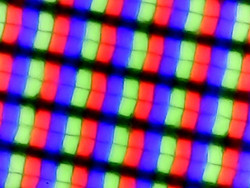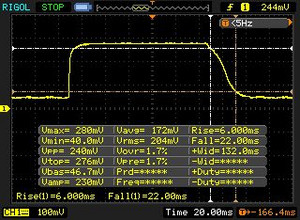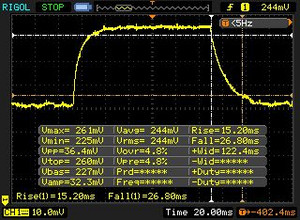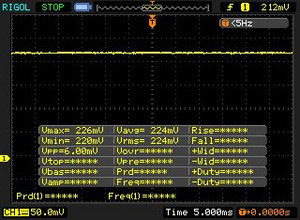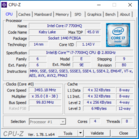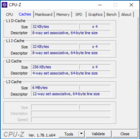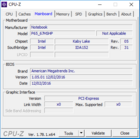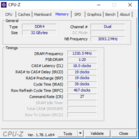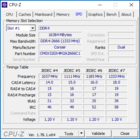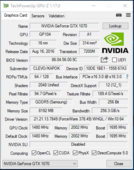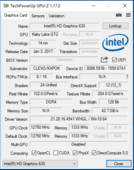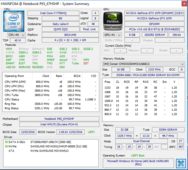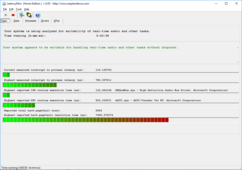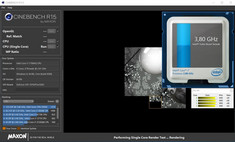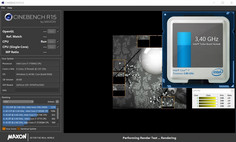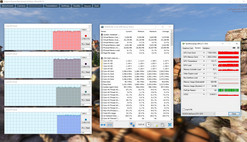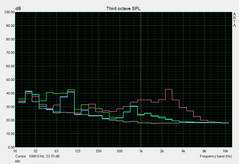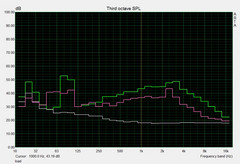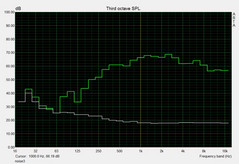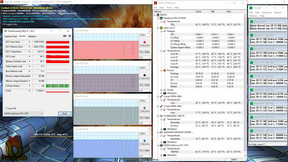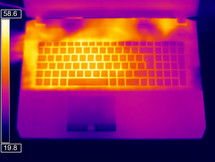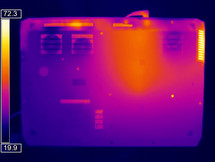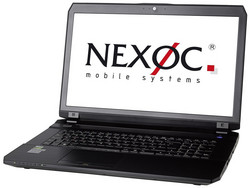Nexoc G734IV (Clevo P670HS-G) Notebook Review

For the original German review, see here.
The Nexoc G734IV is the identically designed successor to the G734III, which we have already reviewed. The only difference between the two models can be found on the inside: The G734IV has a Kaby Lake processor on-board; the G734III has a Skylake CPU. Our review reveals whether the new processor has any advantages. Rivals of the notebook are devices such as the MSI GT72VR 7RE, the HP Omen 17, the Gigabyte P57X v6, and the Acer Predator 17.
Since the G734IV and the G734III are identical in construction, we will not go into detail about the case, ports, input devices, and the speakers. Corresponding information can be found in the Nexoc G734III review.
SD-Card Reader
| SD Card Reader | |
| average JPG Copy Test (av. of 3 runs) | |
| MSI GT72VR 7RE-433 | |
| Acer Predator 17 G9-793-77LG | |
| Nexoc G734III | |
| Gigabyte P57X v6 | |
| HP Omen 17-w110ng | |
| Nexoc G734IV | |
| maximum AS SSD Seq Read Test (1GB) | |
| MSI GT72VR 7RE-433 | |
| Gigabyte P57X v6 | |
| Acer Predator 17 G9-793-77LG | |
| Nexoc G734IV | |
| HP Omen 17-w110ng | |
| Nexoc G734III | |
Communication
| Networking | |
| iperf3 transmit AX12 | |
| MSI GT72VR 7RE-433 | |
| HP Omen 17-w110ng | |
| Nexoc G734IV | |
| iperf3 receive AX12 | |
| Nexoc G734IV | |
| HP Omen 17-w110ng | |
| MSI GT72VR 7RE-433 | |
Display
The G734IV has a bright, high-contrast IPS display with stable viewing angles and a native resolution of 1920x1080 pixels. It is the same panel that is built into the Nexoc G734III. Nevertheless, the measured values are somewhat different, but this is normal, since two structurally identical panels never match 100%.
| |||||||||||||||||||||||||
Brightness Distribution: 91 %
Center on Battery: 348 cd/m²
Contrast: 1088:1 (Black: 0.32 cd/m²)
ΔE Color 4.13 | 0.5-29.43 Ø5
ΔE Greyscale 3.52 | 0.57-98 Ø5.3
84% sRGB (Argyll 1.6.3 3D)
55% AdobeRGB 1998 (Argyll 1.6.3 3D)
61.2% AdobeRGB 1998 (Argyll 2.2.0 3D)
83.7% sRGB (Argyll 2.2.0 3D)
66.2% Display P3 (Argyll 2.2.0 3D)
Gamma: 2.32
| Nexoc G734IV LG Philips LP173WF4-SPD1 (LGD046C), 1920x1080 | Nexoc G734III LG Philips LP173WF4-SPD1 (LGD046C), 1920x1080 | MSI GT72VR 7RE-433 Chi Mei N173HHE-G32 (CMN1747), 1920x1080 | HP Omen 17-w110ng LG Philips LGD046E, 1920x1080 | Gigabyte P57X v6 LGD0469, 1920x1080 | Acer Predator 17 G9-793-77LG AU Optronics B173ZAN01.0 (AUO109B), 3840x2160 | |
|---|---|---|---|---|---|---|
| Display | 3% | 4% | 0% | 4% | 37% | |
| Display P3 Coverage | 66.2 | 67.4 2% | 68.3 3% | 66.6 1% | 68 3% | 86.9 31% |
| sRGB Coverage | 83.7 | 85.8 3% | 86.7 4% | 84.1 0% | 87.5 5% | 100 19% |
| AdobeRGB 1998 Coverage | 61.2 | 62.8 3% | 63.4 4% | 61.5 0% | 64 5% | 99.4 62% |
| Response Times | 16% | 53% | 13% | 15% | 13% | |
| Response Time Grey 50% / Grey 80% * | 42 ? | 36 ? 14% | 29 ? 31% | 37 ? 12% | 33.6 ? 20% | 37 ? 12% |
| Response Time Black / White * | 28 ? | 23 ? 18% | 7 ? 75% | 24 ? 14% | 25.6 ? 9% | 24 ? 14% |
| PWM Frequency | 50 ? | |||||
| Screen | -1% | -34% | 0% | -12% | 13% | |
| Brightness middle | 348 | 314 -10% | 299 -14% | 362 4% | 329.2 -5% | 336 -3% |
| Brightness | 336 | 308 -8% | 277 -18% | 342 2% | 321 -4% | 320 -5% |
| Brightness Distribution | 91 | 92 1% | 87 -4% | 87 -4% | 93 2% | 88 -3% |
| Black Level * | 0.32 | 0.28 12% | 0.27 16% | 0.31 3% | 0.267 17% | 0.25 22% |
| Contrast | 1088 | 1121 3% | 1107 2% | 1168 7% | 1233 13% | 1344 24% |
| Colorchecker dE 2000 * | 4.13 | 4.17 -1% | 9.65 -134% | 4.5 -9% | 5.93 -44% | 3.61 13% |
| Colorchecker dE 2000 max. * | 9.21 | 8.94 3% | 15.43 -68% | 9.31 -1% | 11.07 -20% | 6.02 35% |
| Greyscale dE 2000 * | 3.52 | 3.84 -9% | 9.68 -175% | 3.48 1% | 6.72 -91% | 4.78 -36% |
| Gamma | 2.32 95% | 2.41 91% | 1.89 116% | 2.23 99% | 2.12 104% | 2.32 95% |
| CCT | 6228 104% | 6950 94% | 11652 56% | 6144 106% | 7611 85% | 6185 105% |
| Color Space (Percent of AdobeRGB 1998) | 55 | 56 2% | 75 36% | 55 0% | 57 4% | 88 60% |
| Color Space (Percent of sRGB) | 84 | 86 2% | 100 19% | 84 0% | 87 4% | 100 19% |
| Total Average (Program / Settings) | 6% /
2% | 8% /
-15% | 4% /
2% | 2% /
-5% | 21% /
18% |
* ... smaller is better
Display Response Times
| ↔ Response Time Black to White | ||
|---|---|---|
| 28 ms ... rise ↗ and fall ↘ combined | ↗ 6 ms rise | |
| ↘ 22 ms fall | ||
| The screen shows relatively slow response rates in our tests and may be too slow for gamers. In comparison, all tested devices range from 0.1 (minimum) to 240 (maximum) ms. » 67 % of all devices are better. This means that the measured response time is worse than the average of all tested devices (21.5 ms). | ||
| ↔ Response Time 50% Grey to 80% Grey | ||
| 42 ms ... rise ↗ and fall ↘ combined | ↗ 15 ms rise | |
| ↘ 27 ms fall | ||
| The screen shows slow response rates in our tests and will be unsatisfactory for gamers. In comparison, all tested devices range from 0.2 (minimum) to 636 (maximum) ms. » 63 % of all devices are better. This means that the measured response time is worse than the average of all tested devices (33.7 ms). | ||
Screen Flickering / PWM (Pulse-Width Modulation)
| Screen flickering / PWM not detected | |||
In comparison: 53 % of all tested devices do not use PWM to dim the display. If PWM was detected, an average of 17900 (minimum: 5 - maximum: 3846000) Hz was measured. | |||
Performance
With the G734IV, Nexoc delivers a 17.3-inch gaming notebook that is based on the P670HS-G barebone made by the company Clevo. The device can be individually configured on Nexoc's website. Our review unit can be had for about 2,400 Euros (~$2547). There are also preconfigured versions available in the Nexoc shop; the currently most affordable model sports a price of around 1,600 Euros (~$1698).
Processor
While Intel's Core i7-6700HQ (Skylake) processor is used in the Nexoc G734III, the G734IV is powered by its successor: the Core i7-7700HQ (Kaby Lake). It is a quad-core processor that works at a base frequency of 2.8 GHz. The clock speed can be raised to 3.4 GHz (four cores), 3.6 GHz (two cores), or 3.8 GHz (one core) with Turbo, thus achieving 200 to 300 MHz higher clock speeds than its predecessor, which leads to somewhat better results in our CPU tests. There are hardly any architectural differences between Skylake and Kaby Lake. The CPU Turbo is maxed out, so the CPU handles single-threaded applications at 3.4 to 3.8 GHz and multithreaded applications at 3.4 GHz.
| Cinebench R11.5 | |
| CPU Multi 64Bit | |
| MSI GT72VR 7RE-433 | |
| Nexoc G734IV | |
| HP Omen 17-w110ng | |
| Gigabyte P57X v6 | |
| Nexoc G734III | |
| CPU Single 64Bit | |
| MSI GT72VR 7RE-433 | |
| Nexoc G734IV | |
| HP Omen 17-w110ng | |
| Nexoc G734III | |
| Gigabyte P57X v6 | |
| Cinebench R10 | |
| Rendering Multiple CPUs 32Bit | |
| MSI GT72VR 7RE-433 | |
| Nexoc G734IV | |
| HP Omen 17-w110ng | |
| Rendering Single 32Bit | |
| MSI GT72VR 7RE-433 | |
| Nexoc G734IV | |
| HP Omen 17-w110ng | |
| Geekbench 3 | |
| 32 Bit Single-Core Score | |
| Nexoc G734IV | |
| MSI GT72VR 7RE-433 | |
| 32 Bit Multi-Core Score | |
| Nexoc G734IV | |
| MSI GT72VR 7RE-433 | |
| Geekbench 4.0 | |
| 64 Bit Single-Core Score | |
| Nexoc G734IV | |
| MSI GT72VR 7RE-433 | |
| 64 Bit Multi-Core Score | |
| Nexoc G734IV | |
| MSI GT72VR 7RE-433 | |
| JetStream 1.1 - Total Score | |
| HP Omen 17-w110ng | |
| Nexoc G734IV | |
| MSI GT72VR 7RE-433 | |
| Gigabyte P57X v6 | |
| Nexoc G734III | |
System Performance
A powerful processor and a lightning-quick NVMe SSD provide a system that works very swiftly. Our subjective impression is confirmed by the very good results in the PCMark benchmarks. Even though the Nexoc G734IV is above all a gaming notebook, it can also be used in other areas of application, such as photo editing or video editing. The overall performance cannot be increased, as Nexoc has already exhausted everything.
| PCMark 7 Score | 6219 points | |
| PCMark 8 Home Score Accelerated v2 | 4330 points | |
| PCMark 8 Creative Score Accelerated v2 | 5378 points | |
| PCMark 8 Work Score Accelerated v2 | 5288 points | |
Help | ||
| PCMark 8 | |
| Home Score Accelerated v2 | |
| MSI GT72VR 7RE-433 | |
| HP Omen 17-w110ng | |
| Nexoc G734IV | |
| Gigabyte P57X v6 | |
| Nexoc G734III | |
| Acer Predator 17 G9-793-77LG | |
| Work Score Accelerated v2 | |
| MSI GT72VR 7RE-433 | |
| HP Omen 17-w110ng | |
| Nexoc G734IV | |
| Gigabyte P57X v6 | |
| Nexoc G734III | |
Storage Devices
A blazingly fast Samsung PCIe/NVMe SSD serves as the system drive. It is an M.2 model (2280) with a total capacity of 512 GB. The SSD's transfer rates are excellent. The G734IV has a second M.2 slot as well. If you wish to occupy both, you have to use SATA SSDs, which can then form a RAID-0 or RAID-1 array. The inside of the notebook additionally offers space for two 2.5-inch hard drives. One is already on board; it has a capacity of 2 TB and operates at 5400 RPM.
| Nexoc G734IV Samsung SM961 MZVKW512HMJP m.2 PCI-e | Nexoc G734III Samsung SM951 MZVPV256HDGL m.2 PCI-e | MSI GT72VR 7RE-433 Kingston RBU-SNS8152S3256GG5 | HP Omen 17-w110ng Samsung PM951 NVMe MZVLV256 | Gigabyte P57X v6 Transcend MTS800 256GB M.2 (TS256GMTS800) | |
|---|---|---|---|---|---|
| CrystalDiskMark 3.0 | 5% | -48% | -28% | -57% | |
| Read Seq | 2268 | 1917 -15% | 521 -77% | 1156 -49% | 481.7 -79% |
| Write Seq | 1559 | 1283 -18% | 311.8 -80% | 294.9 -81% | 315.4 -80% |
| Read 512 | 413.8 | 871 110% | 403.1 -3% | 616 49% | 303.1 -27% |
| Write 512 | 1167 | 1199 3% | 332.3 -72% | 294.7 -75% | 314.4 -73% |
| Read 4k | 54 | 51 -6% | 33.35 -38% | 42.7 -21% | 25.93 -52% |
| Write 4k | 154.9 | 142.1 -8% | 111.1 -28% | 153.3 -1% | 84.6 -45% |
| Read 4k QD32 | 634 | 603 -5% | 331.1 -48% | 600 -5% | 273.9 -57% |
| Write 4k QD32 | 509 | 382.4 -25% | 318.3 -37% | 295.3 -42% | 274.9 -46% |
Graphics Card
As far as the GPU is concerned, the G734IV and the G734III are identically equipped: Both computers come with Nvidia's GeForce GTX 1070 graphics core. The GPU supports DirectX 12 and achieves speeds of up to 1886 MHz. However, this value can only be maintained for a short while. During our tests, the average speed of the GPU is at around 1700 MHz. The core is supported by 8192 MB of GDDR5 RAM. The results of the 3DMark benchmarks are at a normal level for this graphics core.
In the control center of the Nexoc notebook, you can choose between two modes: "MSHybrid" and "Separate". The first means that the built-in switchable graphics solution (Optimus) is activated. The second option activates G-Sync. Subsequently, only the dedicated graphics core operates. We performed all tests with Optimus.
| 3DMark 11 Performance | 15979 points | |
| 3DMark Ice Storm Standard Score | 92034 points | |
| 3DMark Cloud Gate Standard Score | 25308 points | |
| 3DMark Fire Strike Score | 13940 points | |
| 3DMark Fire Strike Extreme Score | 7643 points | |
| 3DMark Time Spy Score | 5385 points | |
Help | ||
| 3DMark 11 - 1280x720 Performance GPU | |
| Gigabyte P57X v6 | |
| MSI GT72VR 7RE-433 | |
| Nexoc G734IV | |
| Acer Predator 17 G9-793-77LG | |
| Nexoc G734III | |
| HP Omen 17-w110ng | |
| 3DMark - 1920x1080 Fire Strike Graphics | |
| MSI GT72VR 7RE-433 | |
| Nexoc G734IV | |
| Nexoc G734III | |
| HP Omen 17-w110ng | |
| Acer Predator 17 G9-793-77LG | |
Gaming Performance
All titles in our database can be played on the Nexoc G734IV, even in Full HD resolution and with high to maximum quality settings. The processing power of the built-in hardware is also more than sufficient for 4K resolution, but you would have to connect an appropriate monitor for that.
| BioShock Infinite - 1920x1080 Ultra Preset, DX11 (DDOF) | |
| MSI GT72VR 7RE-433 | |
| Nexoc G734IV | |
| Gigabyte P57X v6 | |
| Nexoc G734III | |
| HP Omen 17-w110ng | |
| Battlefield 4 - 1920x1080 Ultra Preset AA:4x MS | |
| MSI GT72VR 7RE-433 | |
| Nexoc G734IV | |
| Acer Predator 17 G9-793-77LG | |
| Civilization VI - 1920x1080 Ultra Preset AA:4xMS | |
| MSI GT72VR 7RE-433 | |
| Nexoc G734IV | |
| Resident Evil 7 - 1920x1080 Very High / On AA:FXAA+T | |
| Nexoc G734IV | |
| low | med. | high | ultra | |
| Tomb Raider (2013) | 405.7 | 417.6 | 354.6 | 202.5 |
| BioShock Infinite (2013) | 191.6 | 177.4 | 168.6 | 124.1 |
| Battlefield 4 (2013) | 199.3 | 197.7 | 197.1 | 136.7 |
| Rise of the Tomb Raider (2016) | 179.7 | 163.5 | 104.6 | 90.3 |
| Ashes of the Singularity (2016) | 78 | 73 | 65.5 | |
| Deus Ex Mankind Divided (2016) | 140.3 | 127.1 | 82.1 | 42.1 |
| Civilization VI (2016) | 73.9 | 58 | 52 | 51.6 |
| Resident Evil 7 (2017) | 359.6 | 273.9 | 160.9 | 132.8 |
Emissions
System Noise
The automatic fan control is activated during our test. Nexoc should readjust it, as one of the three fans is always running in idle mode, resulting in permanent noise. Every now and then, the cooling system unnecessarily works at full force. If you want less noise, you have to take care of it yourself: The fan control can be manipulated in the notebook's control center. However, the laptop is always clearly audible under load. During our stress test, we measure a sound pressure level of 56 dB; in an everyday gaming situation, the noise level is between 46 and 50 dB.
Noise Level
| Idle |
| 34 / 35 / 46 dB(A) |
| Load |
| 49 / 56 dB(A) |
 | ||
30 dB silent 40 dB(A) audible 50 dB(A) loud |
||
min: | ||
| Nexoc G734IV i7-7700HQ, GeForce GTX 1070 Mobile | Nexoc G734III 6700HQ, GeForce GTX 1070 Mobile | MSI GT72VR 7RE-433 i7-7700HQ, GeForce GTX 1070 Mobile | HP Omen 17-w110ng 6700HQ, GeForce GTX 1070 Mobile | Gigabyte P57X v6 6700HQ, GeForce GTX 1070 Mobile | Acer Predator 17 G9-793-77LG 6700HQ, GeForce GTX 1070 Mobile | |
|---|---|---|---|---|---|---|
| Noise | 10% | 10% | 8% | 8% | 6% | |
| off / environment * | 30 | 30 -0% | 31 -3% | 30 -0% | 29.7 1% | 31 -3% |
| Idle Minimum * | 34 | 31 9% | 34 -0% | 33 3% | 33.2 2% | 33 3% |
| Idle Average * | 35 | 32 9% | 35 -0% | 34 3% | 33.2 5% | 34 3% |
| Idle Maximum * | 46 | 33 28% | 37 20% | 35 24% | 33.2 28% | 40 13% |
| Load Average * | 49 | 49 -0% | 37 24% | 45 8% | 47.5 3% | 44 10% |
| Load Maximum * | 56 | 50 11% | 44 21% | 52 7% | 52.5 6% | 50 11% |
* ... smaller is better
Temperature
The G734IV finishes our stress test (Prime95 and FurMark run for at least an hour) differently depending on whether it is running on battery or plugged in. In the latter case, the processor works at 2.8 GHz, occasionally being slowed down to 700 MHz. The GPU's clock speed is at around 1400 MHz. In battery operation, the CPU mainly works at 1.7 GHz, while the graphics core fluctuates between 600 and 1443 MHz. The notebook does not warm up significantly during the test; only one measuring point reaches a considerably elevated temperature. The heat development is not so extreme in day-to-day use, since our stress test is an extreme scenario that does not occur in everyday use.
(-) The maximum temperature on the upper side is 48.1 °C / 119 F, compared to the average of 40.4 °C / 105 F, ranging from 21.2 to 68.8 °C for the class Gaming.
(-) The bottom heats up to a maximum of 59.3 °C / 139 F, compared to the average of 43.2 °C / 110 F
(+) In idle usage, the average temperature for the upper side is 25 °C / 77 F, compared to the device average of 33.8 °C / 93 F.
(+) The palmrests and touchpad are cooler than skin temperature with a maximum of 30.9 °C / 87.6 F and are therefore cool to the touch.
(±) The average temperature of the palmrest area of similar devices was 28.9 °C / 84 F (-2 °C / -3.6 F).
| Nexoc G734IV i7-7700HQ, GeForce GTX 1070 Mobile | Nexoc G734III 6700HQ, GeForce GTX 1070 Mobile | MSI GT72VR 7RE-433 i7-7700HQ, GeForce GTX 1070 Mobile | HP Omen 17-w110ng 6700HQ, GeForce GTX 1070 Mobile | Gigabyte P57X v6 6700HQ, GeForce GTX 1070 Mobile | Acer Predator 17 G9-793-77LG 6700HQ, GeForce GTX 1070 Mobile | |
|---|---|---|---|---|---|---|
| Heat | -3% | 9% | -0% | -18% | 2% | |
| Maximum Upper Side * | 48.1 | 50 -4% | 41.5 14% | 45 6% | 59 -23% | 42.6 11% |
| Maximum Bottom * | 59.3 | 60.5 -2% | 50.6 15% | 54.3 8% | 66 -11% | 44.9 24% |
| Idle Upper Side * | 28.2 | 29.1 -3% | 26.4 6% | 29.6 -5% | 33.2 -18% | 33.1 -17% |
| Idle Bottom * | 26 | 26.9 -3% | 25.4 2% | 28.6 -10% | 30.6 -18% | 28.9 -11% |
* ... smaller is better
Speakers
Nexoc G734IV audio analysis
(±) | speaker loudness is average but good (77 dB)
Bass 100 - 315 Hz
(±) | reduced bass - on average 14.7% lower than median
(±) | linearity of bass is average (13.9% delta to prev. frequency)
Mids 400 - 2000 Hz
(+) | balanced mids - only 3.5% away from median
(+) | mids are linear (4% delta to prev. frequency)
Highs 2 - 16 kHz
(+) | balanced highs - only 3.3% away from median
(+) | highs are linear (6.4% delta to prev. frequency)
Overall 100 - 16.000 Hz
(±) | linearity of overall sound is average (17.3% difference to median)
Compared to same class
» 44% of all tested devices in this class were better, 12% similar, 44% worse
» The best had a delta of 6%, average was 18%, worst was 132%
Compared to all devices tested
» 27% of all tested devices were better, 8% similar, 65% worse
» The best had a delta of 4%, average was 25%, worst was 134%
MSI GT72VR 7RE-433 audio analysis
(+) | speakers can play relatively loud (87 dB)
Bass 100 - 315 Hz
(±) | reduced bass - on average 5.4% lower than median
(±) | linearity of bass is average (11.3% delta to prev. frequency)
Mids 400 - 2000 Hz
(±) | higher mids - on average 5% higher than median
(+) | mids are linear (4.1% delta to prev. frequency)
Highs 2 - 16 kHz
(+) | balanced highs - only 4.7% away from median
(+) | highs are linear (5.7% delta to prev. frequency)
Overall 100 - 16.000 Hz
(+) | overall sound is linear (11.7% difference to median)
Compared to same class
» 10% of all tested devices in this class were better, 3% similar, 87% worse
» The best had a delta of 6%, average was 18%, worst was 132%
Compared to all devices tested
» 6% of all tested devices were better, 2% similar, 92% worse
» The best had a delta of 4%, average was 25%, worst was 134%
Frequency diagram in comparison (checkboxes above are selectable/deselectable!)
Energy Management
Power Consumption
We measure a maximum power consumption of 22 watts in idle mode. The G734IV is thus slightly more modest than its Skylake predecessor. The results are different under load: The power requirement of the Nexoc laptop rises up to 224 watts during our stress test, slowly pushing the 230-watt power supply to its limits. The notebook's consumption varies between 74 and 92 watts (average: 86 watts) while gaming.
| Off / Standby | |
| Idle | |
| Load |
|
| Nexoc G734IV i7-7700HQ, GeForce GTX 1070 Mobile | Nexoc G734III 6700HQ, GeForce GTX 1070 Mobile | MSI GT72VR 7RE-433 i7-7700HQ, GeForce GTX 1070 Mobile | HP Omen 17-w110ng 6700HQ, GeForce GTX 1070 Mobile | Gigabyte P57X v6 6700HQ, GeForce GTX 1070 Mobile | Acer Predator 17 G9-793-77LG 6700HQ, GeForce GTX 1070 Mobile | |
|---|---|---|---|---|---|---|
| Power Consumption | -10% | -30% | -27% | -40% | -69% | |
| Idle Minimum * | 12 | 13 -8% | 20 -67% | 19 -58% | 18.4 -53% | 25 -108% |
| Idle Average * | 17 | 20 -18% | 27 -59% | 25 -47% | 22.8 -34% | 35 -106% |
| Idle Maximum * | 22 | 27 -23% | 31 -41% | 31 -41% | 24 -9% | 46 -109% |
| Load Average * | 86 | 90 -5% | 86 -0% | 90 -5% | 175.5 -104% | 103 -20% |
| Load Maximum * | 224 | 210 6% | 184 18% | 193 14% | 229.5 -2% | 223 -0% |
* ... smaller is better
Battery Life
In our realistic WLAN test, where we simulate the workload of loading web-pages with a script, the profile "Balanced" is active, the energy-saving functions are deactivated, and the display brightness is lowered to around 150 cd/m², the Nexoc G734IV achieves a runtime of 3:25 h (predecessor: 2:57 h). The notebook finishes our video test after 3:15 h (predecessor: 3:28 h). Here, we let the short film Big Buck Bunny (H.264 codec, 1920x1080 pixels) run in a loop. The wireless modules as well as the energy-saving functions are deactivated, and the display brightness is set to about 150 cd/m². In terms of runtime, the G734IV and G734III are in tight competition: Each achieves better results than the other in two cases. Both computers have the same 60 Wh battery.
| Nexoc G734IV i7-7700HQ, GeForce GTX 1070 Mobile, 60 Wh | Nexoc G734III 6700HQ, GeForce GTX 1070 Mobile, 60 Wh | MSI GT72VR 7RE-433 i7-7700HQ, GeForce GTX 1070 Mobile, 83 Wh | HP Omen 17-w110ng 6700HQ, GeForce GTX 1070 Mobile, 95 Wh | Gigabyte P57X v6 6700HQ, GeForce GTX 1070 Mobile, 75.81 Wh | Acer Predator 17 G9-793-77LG 6700HQ, GeForce GTX 1070 Mobile, 88 Wh | |
|---|---|---|---|---|---|---|
| Battery Runtime | 3% | 6% | 24% | 11% | -6% | |
| Reader / Idle | 463 | 400 -14% | 316 -32% | 432 -7% | 418 -10% | 278 -40% |
| H.264 | 195 | 208 7% | 228 17% | 233 19% | ||
| WiFi v1.3 | 205 | 177 -14% | 230 12% | 247 20% | 201 -2% | 200 -2% |
| Load | 71 | 95 34% | 91 28% | 115 62% | 103 45% | 89 25% |
Verdict
Pros
Cons
The Nexoc G734IV can be primarily put into the category "model update". The new Kaby Lake quad-core processor has only a slight performance advantage over its Skylake predecessor. Just as the G734III, the G734IV can also run all current games smoothly in Full HD resolution with high to maximum quality settings. Activating Nvidia's G-Sync technology ensures smooth images on the 60 Hz display. The matte IPS Full HD display delights with a high degree of brightness, high contrast and stable viewing angles.
With the G734IV, Nexoc delivers a rounded gaming notebook for gamers who like to upgrade their laptop.
The notebook's heat development is within normal limits for a gaming laptop. Nexoc should improve the automatic fan control in idle mode: The fan is always on and sometimes unnecessarily speeds up, which becomes annoying after a while. Fortunately, users can fix this themselves.
A fast NVMe SSD guarantees a very speedy system. The necessary storage space is provided by an also present 2.5-inch hard drive that offers a total of 2 TB of storage. A second 2.5-inch hard drive can be installed if this is not enough. To switch the drives, the bottom case of the notebook would have to be removed.
Nexoc G734IV
-
02/11/2017 v6(old)
Sascha Mölck


 Deutsch
Deutsch English
English Español
Español Français
Français Italiano
Italiano Nederlands
Nederlands Polski
Polski Português
Português Русский
Русский Türkçe
Türkçe Svenska
Svenska Chinese
Chinese Magyar
Magyar